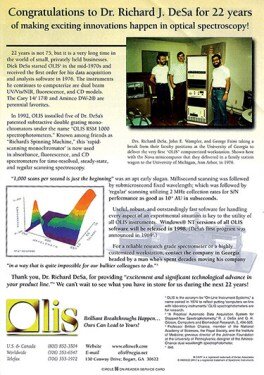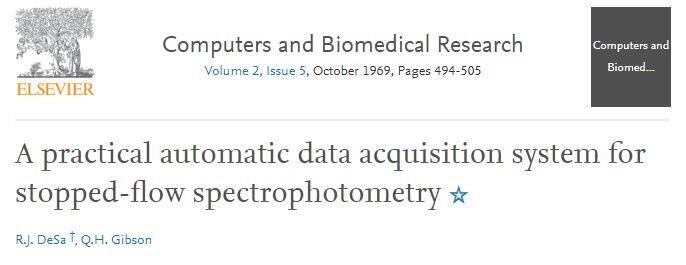How Uv/vis can Save You Time, Stress, and Money.
How Uv/vis can Save You Time, Stress, and Money.
Blog Article
Uv/vis/nir - The Facts
Table of ContentsSpectrophotometers for DummiesNot known Details About Uv/vis/nir The Of Circularly Polarized LuminescenceExcitement About SpectrophotometersFacts About Circularly Polarized Luminescence Revealed

Spectrophotometry is most commonly applied to ultraviolet, noticeable, and infrared radiation, contemporary spectrophotometers can question broad swaths of the electromagnetic spectrum, consisting of x-ray, ultraviolet, visible, infrared, and/or microwave wavelengths. Spectrophotometry is a tool that depends upon the quantitative analysis of molecules depending on just how much light is absorbed by colored substances.
Some Known Incorrect Statements About Circular Dichroism
A spectrophotometer is commonly utilized for the measurement of transmittance or reflectance of solutions, transparent or nontransparent solids, such as refined glass, or gases. Although many biochemicals are colored, as in, they soak up visible light and for that reason can be measured by colorimetric procedures, even colorless biochemicals can often be transformed to colored compounds suitable for chromogenic color-forming responses to yield compounds suitable for colorimetric analysis.: 65 However, they can likewise be designed to determine the diffusivity on any of the noted light ranges that generally cover around 2002500 nm using different controls and calibrations.
An example of an experiment in which spectrophotometry is utilized is the determination of the equilibrium constant of an option. A particular chain reaction within a service might occur in a forward and reverse instructions, where reactants form items and items break down into reactants. At some time, this chain reaction will reach a point of balance called a balance point.
Some Known Details About Spectrophotometers
The amount of light that passes through the solution is a sign of the concentration of certain chemicals that do not allow light to travel through. The absorption of light is because of the interaction of light with the electronic and vibrational modes of particles. Each type of molecule has a private set of energy levels related to the makeup of its chemical bonds and nuclei and hence will take in light of specific wavelengths, or energies, resulting in special spectral homes.
They are extensively used in numerous industries including semiconductors, laser and optical production, printing and forensic assessment, as well as in laboratories for the study of chemical compounds. Spectrophotometry is often utilized in measurements of enzyme activities, determinations of protein concentrations, determinations of enzymatic kinetic constants, and measurements of ligand binding reactions.: 65 Eventually, a spectrophotometer is able to identify, depending on the control or calibration, what compounds are present in a target and precisely how much through calculations of observed wavelengths.
Developed by Arnold O. Beckman in 1940 [], the spectrophotometer was created with the help of his colleagues at his company National Technical Laboratories established in 1935 which would become Beckman Instrument Business and eventually Beckman Coulter. This would come as an option to the previously created spectrophotometers which were unable to take in the ultraviolet properly.
How Uv/vis can Save You Time, Stress, and Money.
It would be found that this did not give satisfactory results, therefore in Model B, there was a shift from a glass to a quartz prism which enabled much better absorbance outcomes - circular dichroism (https://disqus.com/by/julieanndesalorenz/about/). From there, Model C was born with a change to the wavelength resolution which wound up having 3 systems of it produced
It irradiates the sample with polychromatic light which the sample absorbs depending on its homes. Then it is transferred back by grating the photodiode selection which detects the wavelength region of the spectrum. Ever since, the production and execution of spectrophotometry gadgets has actually increased tremendously and has turned into one of the most innovative instruments of our time.

The Ultimate Guide To Circularly Polarized Luminescence
Historically, spectrophotometers utilize a monochromator including a diffraction grating to produce the analytical spectrum. The grating can either be movable or fixed. If a single detector, such as a photomultiplier tube or photodiode is used, the grating can be scanned stepwise (scanning spectrophotometer) so that the detector can measure the light strength at each wavelength (which will correspond to each "step").
In such systems, the grating is repaired and the strength of each wavelength of light is determined by a different detector in the selection. Furthermore, most modern mid-infrared spectrophotometers use a Fourier transform method to acquire the spectral details - https://sketchfab.com/olisclarity1. This method is called Fourier change infrared spectroscopy. When making transmission measurements, the spectrophotometer quantitatively compares the fraction of light that goes through a referral option and a test service, then digitally compares the strengths of the two signals and calculates the percentage of transmission of the sample compared to the referral standard.

Report this page